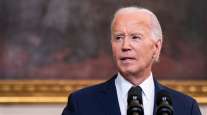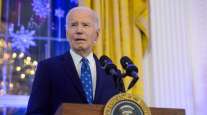Associated Press
Automakers Join Biden in Pledge to Boost EV Sales

[Stay on top of transportation news: Get TTNews in your inbox.]
WASHINGTON — Declaring the U.S. must “move fast” to win the carmaking future, President Joe Biden on Aug. 5 touted a commitment from the auto industry to make electric vehicles account for up to half of U.S. sales by the end of the decade.
Biden wants automakers to raise gas mileage and cut tailpipe pollution between now and model year 2026. That would mark a significant step toward meeting his pledge to cut emissions and battle climate change as he pushes a history-making shift in the U.S. from internal combustion engines to battery-powered vehicles.
He also urged that the components needed to make that sweeping change — from batteries to semiconductors — be made in the United States, reflecting a balance to gain both industry and union support for the environmental effort, with the future promise of new jobs and billions in new federal investments in electric vehicles.
Pointing to electric vehicles parked on the White House South Lawn, the president declared them a “vision of the future that is now beginning to happen.”
“The question is whether we lead or fall behind in the race for the future,” he said, “Folks, the rest of the world is moving ahead. We have to catch up.”
In obvious good spirits, the president hopped in an electric-powered Jeep Rubicon and took a quick drive around the driveway after the ceremony.
Joining Biden at the White House were Mary Barra, chairwoman of General Motors Co., Jim Farley, president of Ford Motor Co., and Mark Stewart, chief operating officer of North America for Stellantis NV, the company formed earlier this year from the merger of Fiat Chrysler and PSA Group.

President Joe Biden signs an executive order on increasing production of electric vehicles. (Susan Walsh/Associated Press)
Several electric and hybrid vehicles were arrayed behind Biden as he spoke, including the Ford F-150 Lightning, Chevrolet Bolt, Jeep Wrangler Limited Rubicon 4xE, GMC Hummer EV and Ford E Transit Van.
Earlier in the day, the administration announced there would be new mileage and anti-pollution standards from the Environmental Protection Agency and Transportation Department, part of Biden’s goal to cut U.S. greenhouse gas emissions in half by 2030. It said the auto industry had agreed to a target that 40% to 50% of new vehicle sales be electric by 2030.
Both the regulatory standards and the automakers’ voluntary target were included in an executive order that Biden signed as the gathering of auto industry leaders and lawmakers applauded.
The standards, which have to go through the regulatory process including public comments, would reverse fuel economy and anti-pollution rollbacks done under President Donald Trump. At that time, the increases were reduced to 1.5% annually through model year 2026.
Still, it remained to be seen how quickly consumers would be willing to embrace higher mileage, lower-emission vehicles over less fuel-efficient SUVs, currently the industry’s top seller. The 2030 EV targets ultimately are nonbinding, and the industry stressed that billions of dollars in electric-vehicle investments in legislation pending in Congress will be vital to meeting those goals.

President Joe Biden walks with United Auto Works Local 600 president Bernie Ricky. (Susan Walsh/Associated Press)
Only 2.2% of new-vehicle sales were fully electric vehicles through June, according to Edmunds.com estimates. That’s up from 1.4% at the same time last year.
Biden has long declared himself “a car guy,” his blue-collar political persona intertwined with support for union workers and his role, as vice president, in steadying the auto industry after the economic collapse in 2008. He also joked to Barra that he wanted to reserve a test drive.
“I have a commitment from Mary: When they make the first electric Corvette, I get to drive it,” Biden said. “Right, Mary? You think I’m kidding. I’m not kidding.”
The new standards would cut greenhouse gas emissions and raise fuel economy by 10% over the Trump rules in car model year 2023, followed by 5% increases in reductions in each model year through 2026, according to an EPA statement. That’s about a 25% increase over four years.
“These robust standards are underpinned by sound science and technical expertise, encouraging the development of technology and innovation that will drive America forward into a clean energy future,” EPA Administrator Michael Regan said in the statement.
Last week, the Associated Press and other news organizations reported that the Biden administration was discussing weaker mileage requirements with automakers, but they apparently have been strengthened. The change came after environmental groups complained publicly that they were too weak to address a serious problem.

What's next for data gathering and analytics programs in trucking? Host Seth Clevenger speaks with Andrew Johnson of PrePass Safety Alliance and Chris Orban of Trimble Transportation. Hear a snippet above, and get the full program by going to RoadSigns.TTNews.com.
Transportation is the single biggest U.S. contributor to climate change. Autos in the U.S. spewed 824 million tons of heat-trapping carbon dioxide in 2019, about 14% of total U.S. emissions, according to the EPA.
The voluntary deal with automakers defines electric vehicles as plug-in hybrids, fully electric vehicles and those powered by hydrogen fuel cells.
Environmental groups welcomed the movement but also said the administration should move faster.
“This proposal helps get us back on the road to cleaning up tailpipe pollution,” said Simon Mui of the Natural Resources Defense Council. “But given how climate change has already turned our weather so violent, it’s clear that we need to dramatically accelerate progress.”
Several automakers already have announced similar electric vehicle sales goals to those in the deal with the government. Last week, for instance, Ford’s CEO said his company expects 40% of its global sales to be fully electric by 2030. General Motors has said it aspires to sell only electric passenger vehicles by 2035. Stellantis also pledged over 40% electrified vehicles by 2030.
The Trump rollback of the Obama-era standards would require a projected 29 mpg in “real world” stop-and-start driving by 2026. It wasn’t clear what the real-world mileage would be under the Biden standards. Under Obama administration rules, it would have increased to 37 mpg.
Automakers said they would work toward the 40% to 50% electric vehicle sales goal.
“You can count on Toyota to do our part,” said Ted Ogawa, the company’s North America CEO.
General Motors, Stellantis and Ford said in a joint statement that their recent electric-vehicle commitments show they want to lead the U.S. in the transition away from combustion vehicles.
They said the change is a “dramatic shift” from the U.S. market today, and can only happen with policies that include incentives for electric vehicle purchases, adequate government funding for charging stations and money to expand electric vehicle manufacturing and the parts supply chain.
Associated Press writers Hope Yen, Jonathan Lemire and Seth Borenstein in Washington contributed to this report. Bloomberg News also contributed.
Want more news? Listen to today's daily briefing below or go here for more info:




